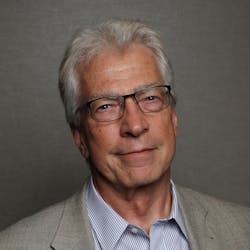
As the unstable global stock markets make everyone nervous and China shows signs of a severe slowdown, I would like to remind readers that photonics is a matrix of science, technologies, products, and markets. And fortunately, these are not limited by geographic location, specific technology, or product type. Markets such as communications or manufacturing have experienced booms and busts, but the continuing technical advances and entrepreneurial creativity elsewhere in the matrix ensure that many great opportunities exist.
Our cover story this month illustrates how technology keeps creating new opportunities, in this case with improved short-wavelength infrared imaging with electron-initiated avalanche photodiodes (see page 37). In his article on the past and future of spectroscopy, contributing editor Jeff Hecht documents how improvements in performance, size, and cost of spectrometers have consistently opened new markets (see page 29). And Evgeny Dianov, scientific director of the Fiber Optics Research Center of the Russian Academy of Sciences, shows how years of progress in bismuth-doped optical fibers have created an active laser media with great potential in several markets (see page 49).
And for the markets of the future: congratulations and thanks are in order to everyone who worked on the new national integrated photonics manufacturing institute. The award for the institute went to a consortium led by the State University of New York Polytechnic Institute and the University of Rochester. The new American Institute for Manufacturing Photonics (AIM Photonics) will be headquartered in Rochester, with partners and cooperating institutions across the country (see the White House fact sheet and video: http://1.usa.gov/1Msu5kL).
Funding from the U.S. Air Force Research Lab and support from New York State and industry will total over $600 million. Vice President Joe Biden made the formal announcement in Rochester on July 27, and plenty of politicians were in attendance—but the real stars were the members of the U.S. National Photonics Initiative, who brought the political leaders there with years of dedicated work.
About the Author

Conard Holton
Conard Holton has 25 years of science and technology editing and writing experience. He was formerly a staff member and consultant for government agencies such as the New York State Energy Research and Development Authority and the International Atomic Energy Agency, and engineering companies such as Bechtel. He joined Laser Focus World in 1997 as senior editor, becoming editor in chief of WDM Solutions, which he founded in 1999. In 2003 he joined Vision Systems Design as editor in chief, while continuing as contributing editor at Laser Focus World. Conard became editor in chief of Laser Focus World in August 2011, a role in which he served through August 2018. He then served as Editor at Large for Laser Focus World and Co-Chair of the Lasers & Photonics Marketplace Seminar from August 2018 through January 2022. He received his B.A. from the University of Pennsylvania, with additional studies at the Colorado School of Mines and Medill School of Journalism at Northwestern University.